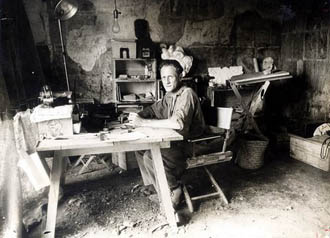Frans Blom: Tulane"s "Indiana Jones"
The year was 1925 and the world was much larger, rugged and less known. Tulane archeologist Frans Blom, along with a small team, set out on the first of what would be many expeditions to the jungles and mountains of Mexico and Guatemala to study the ancient remains, customs and languages of what he considered “the most notable of the ancient population of America, the Maya Indians.”

Serving as Middle American Research Institute director from 1926 to 1940, Frans Blom led several expeditions through the Maya regions of Mexico and Central America. In this photo, Blom is seen at his camp during an exploration of the Uxmal ruins in the Yucatan.
Through his fieldwork, the indefatigable Blom, an early director of Tulane's Middle American Research Institute, would bring to campus a trove of historical objects and knowledge. The fact that MARI is one of the nation's leading centers for research on Middle America is in no small part due to the exploits of Blom, says Kathe Lawton, assistant director of MARI, who likens Blom to the fictional character Indiana Jones.
“He was very much the dashing young man,” says Lawton. “He was gorgeous, and the women uptown loved him.” In her 30 years working at MARI, Lawton has become something of an expert on not only Blom, but also the institute's extensive collection that until very recently inhabited the “musty, dusty” upper floor of Dinwiddie Hall.
If Lawton feels a certain kinship with Blom, it is perhaps due to a shared dream for proper housing for the institute's valuable collection. While Blom experienced great success in the field, he was less successful in convincing the university to give him a better facility.
“At the time Blom was trying to expand MARI because he was running out of space,” says Lawton. “The roof leaked. He had to put buckets under the leaks. I'd been doing that.”
As part of the extensive renovation of Dinwiddie Hall, MARI is undergoing a significant modernization and expansion that will be completed in fall 2011.
“It's taken 85 years,” says Lawton, “and now we are on the brink of doing what he wanted.”
